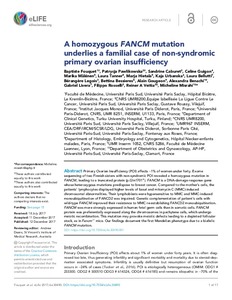A homozygous FANCM mutation underlies a familial case of non-syndromic primary ovarian insufficiency
Fouquet B; Pawlikowska P; Caburet S; Guigon C; Mäkinen M; Tanner L; Hietala M; Urbanska K; Bellutti L; Legois B; Bessieres B; Gougeon A; Benachi A; Livera G; Rosselli F; Veitia RA; Misrashi M; Misrashi M
A homozygous FANCM mutation underlies a familial case of non-syndromic primary ovarian insufficiency
Fouquet B
Pawlikowska P
Caburet S
Guigon C
Mäkinen M
Tanner L
Hietala M
Urbanska K
Bellutti L
Legois B
Bessieres B
Gougeon A
Benachi A
Livera G
Rosselli F
Veitia RA
Misrashi M
Misrashi M
ELIFE SCIENCES PUBLICATIONS LTD
Julkaisun pysyvä osoite on:
https://urn.fi/URN:NBN:fi-fe2021042718707
https://urn.fi/URN:NBN:fi-fe2021042718707
Tiivistelmä
Primary Ovarian Insufficiency (P01) affects 1% of women under forty. Exome sequencing of two Finnish sisters with non-syndromic P01 revealed a homozygous mutation in FANCM, leading to a truncated protein (p.GIn1701*). FANCM is a DNA-damage response gene whose heterozygous mutations predispose to breast cancer. Compared to the mother's cells, the patients' lymphocytes displayed higher levels of basal and mitomycin C (MMC)-induced chromosomal abnormalities. Their lymphoblasts were hypersensitive to MMC and MMC-induced monoubiquitination of FANCD2 was impaired. Genetic complementation of patient's cells with wild-type FANCM improved their resistance to MMC re-establishing FANCD2 monoubiquitination. FANCM was more strongly expressed in human fetal germ cells than in somatic cells. FANCM protein was preferentially expressed along the chromosomes in pachytene cells, which undergo meiotic recombination. This mutation may provoke meiotic defects leading to a depleted follicular stock, as in Fancrril- mice. Our findings document the first Mendelian phenotype due to a biallelic FANCM mutation.
Kokoelmat
- Rinnakkaistallenteet [27094]
